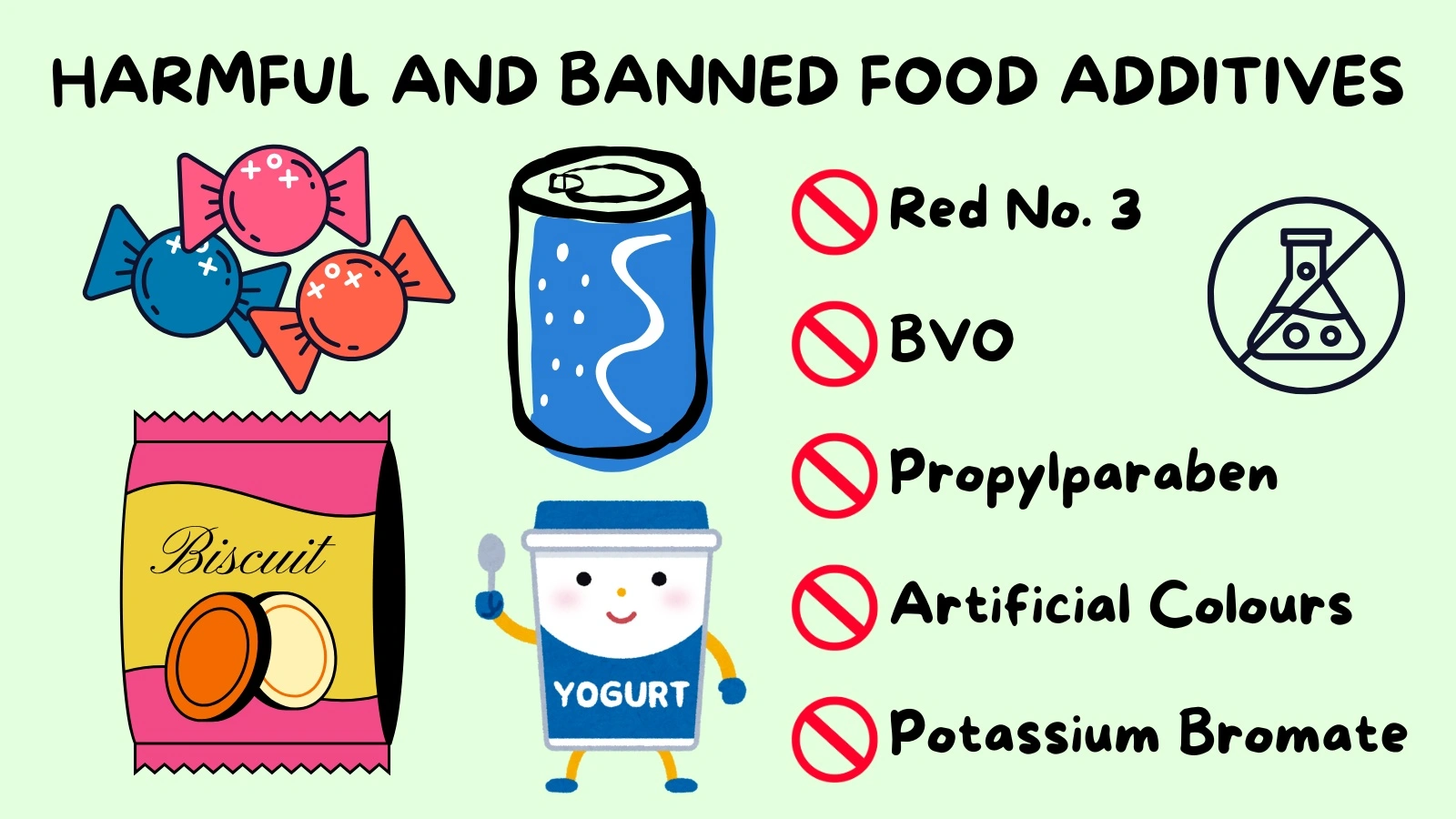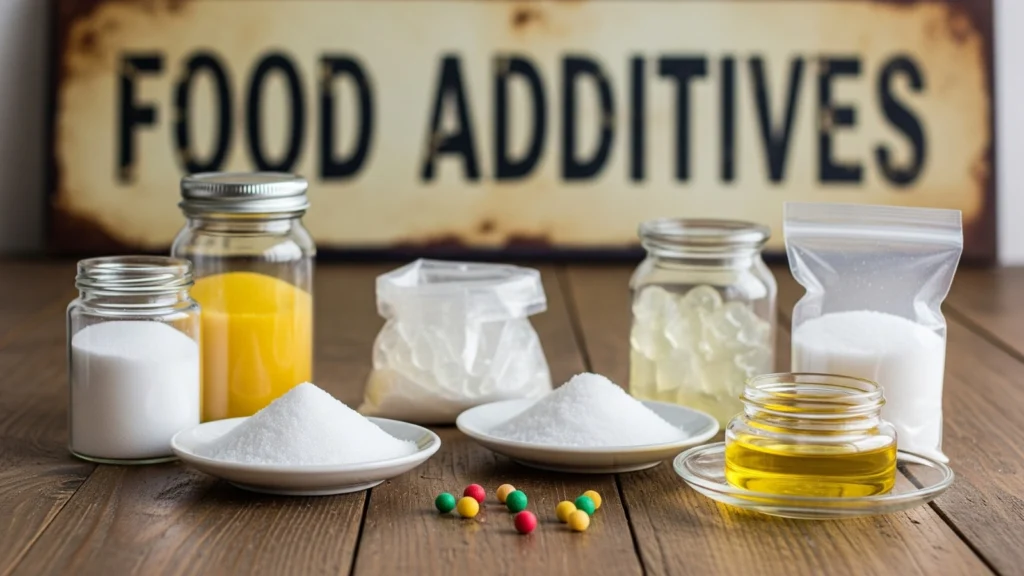Smart Choices Start with Real Facts.
Harmful and Banned Food Additives in 2025: What You Need to Know

- What Are Food Additives?
- Why Some Additives Get the Boot
- Additives I Watch For (And What I’ve Learned About Them)
- 1. Red No. 3 (Erythrosine)
- 2. BVO (Brominated Vegetable Oil)
- 3. Potassium Bromate
- 4. Propylparaben
- 5. Artificial Colours (Red 40, Yellow 5, Blue 1, etc.)
- How They Affect You (and Me)
- The Global Rulebook Problem
- My Go-To Rules for Avoiding the Worst Stuff
- A Real Day in My Kitchen
- Final Thought (With Coffee in Hand)
- FAQs
Last weekend, I was at the grocery store with my little basket, planning to “just” grab bread and maybe some fruit. You know how that goes. I wandered into the snack aisle (dangerous move) and spotted a bright box of fruity something that I used to love as a kid.
Front of the pack? Bold words like “Made with Real Fruit!” and “Good Source of Vitamin C!” Big checkmarks, happy colours. Looked harmless… until I flipped it over.
The ingredients list was like reading a foreign language — Red 40, Yellow 5, and something that sounded suspiciously like a floor cleaner.
It hit me:
We’re often more focused on what the packaging shouts at us than the fine print that matters.
Today, I want to break down some of the additives I’ve learned to spot (and avoid), without making it sound like a boring chemistry class.

What Are Food Additives?
Okay — quick definition, no science degree required.
Food additives are extras that companies put in food to make it look, taste, or last the way they want it to.
They can be:
- Preservatives – so products survive long shipping or storage.
- Colours – so your sweets are neon pink instead of pale beige.
- Flavours – so something tastes “extra cheesy” when there’s barely any real cheese in the recipe.
Some of these are harmless. You’ve probably used lemon juice to keep avocado from browning — that’s technically a natural preservative. But some additives are synthetic, and through years of use, studies have shown they might be harmful in the long run.
And here’s the kicker — the ones I’m talking about today aren’t fringe stories. Many have been on store shelves for decades before being questioned or banned.
Why Some Additives Get the Boot
The short answer? Science catches up.
When new studies show a link between a certain additive and serious health risks — cancer, hormone disruption, behavioural effects in children — regulators take another look.
The frustrating part is that not every country reacts at the same speed.
What’s banned in the EU might still be sitting in an American pantry. In the U.S., even different states have their own rules.
It’s like food safety is on a different clock depending on where you live.

Additives I Watch For (And What I’ve Learned About Them)
These aren’t random — these are ones I’ve spotted often while shopping and see repeatedly in health reports.
1. Red No. 3 (Erythrosine)
Where I’ve seen it: candies, frosted pastries, certain drinks.
Why it’s bad news: linked in animal studies to cancer; parents often note kids getting extra restless after foods with certain dyes.
Status: banned in the U.S. from 2025; the EU had already banned it years before.
Little personal note — I once grabbed a “cherry” jelly for my niece, thinking it was fruit-based. Nope. Red No. 3 right there, halfway down the list. Back it went.
2. BVO (Brominated Vegetable Oil)
Where I’ve seen it: citrus-flavoured sodas and some “energy” drinks.
Why skip it: sticks around in body fat, can affect hormones and nerves.
Status: banned in the U.S. as of 2024; never used in Europe for decades.
True story — one day, I compared two orange sodas (same brand, one from the U.S., one imported from Europe). One had BVO, the other didn’t. Same flavour claims. Which means… yep, it can be made without it.
3. Potassium Bromate
Where I’ve seen it: mass-produced bread, burger buns, pizza crust.
Why skip it: labelled a possible carcinogen (animal studies show kidney and thyroid damage).
Status: banned in more than 100 countries; California will follow by 2027.
Confession: I used to eat certain supermarket breads daily without even looking at the label. Now, I stick to bakery bread without the long list.
4. Propylparaben
Where I’ve seen it: packaged cakes, cookies, bread.
Why skip it: can mess with hormones and possibly fertility.
Status: Some U.S. states are phasing it out; under review by the FDA.
Sometimes it’s hiding under “antimicrobial preservative.” That’s your clue.
5. Artificial Colours (Red 40, Yellow 5, Blue 1, etc.)
Where I’ve seen it: kids’ cereal, sports drinks, “fun” flavoured yogurts.
Why skip it: linked to hyperactivity in some children, and research suggests possible cancer risks for a few dyes.
Status: restricted or banned in many countries; labelled with warnings in the EU.
A little trick I learned — fruit isn’t naturally neon. If it’s glowing, it’s probably artificial.
How They Affect You (and Me)
Most of these aren’t going to make you sick instantly. The problem is steady exposure over the years.
Health risks include:
- Higher cancer likelihood (in certain doses over time)
- Behavioural changes in kids
- Endocrine/hormone changes
- Possible metabolic and immune effects
Kids and pregnant women are often more vulnerable — their bodies are still developing or working harder to support growth.
The Global Rulebook Problem
I keep saying this because it shocks me every time: the EU bans over 1,000 additives that the U.S. still allows. That’s not to say all of them are equally harmful, but it does make you pause.
Lately, states like California and New York are moving toward tougher laws, which is a good sign. But until laws catch up everywhere, it’s on us to decide what goes in our kitchens.
My Go-To Rules for Avoiding the Worst Stuff
These are super simple and doable — you don’t have to be an ingredient expert.
- Flip the box – ignore the front marketing, go straight to the back.
- If it sounds like a lab chemical, ask yourself if it’s worth it.
- Shop the outer aisles – that’s where they keep fresh produce, dairy, and bakery items (usually fewer additives).
- Support clean brands – if a company brags “no artificial colours or preservatives,” that’s a good sign.
- Don’t stress perfection – even I eat packaged snacks sometimes. It’s about reducing, not obsessing.
A Real Day in My Kitchen
Breakfast: oatmeal with banana and a drizzle of honey (no labels needed).
Lunch: a salad with roasted chicken I made at home — I check marinades for hidden preservatives.
Snack: popcorn (just kernels and salt, no yellow food dye, thank you very much).
I still enjoy treats, but I try to make them or buy them from places that keep it simple.
Final Thought (With Coffee in Hand)
We’re never going to live in a world where everything is 100% pure. But we can live in one where we choose smarter, eat fresher, and stop giving free passes to ingredients that don’t deserve to be there.
And trust me — when you start eating fewer additives, you taste the difference. Real food just tastes… well, real.
So next time you’re at the store, do what I do. Flip it over. Read it. Put half of them back. Your future self will thank you.









